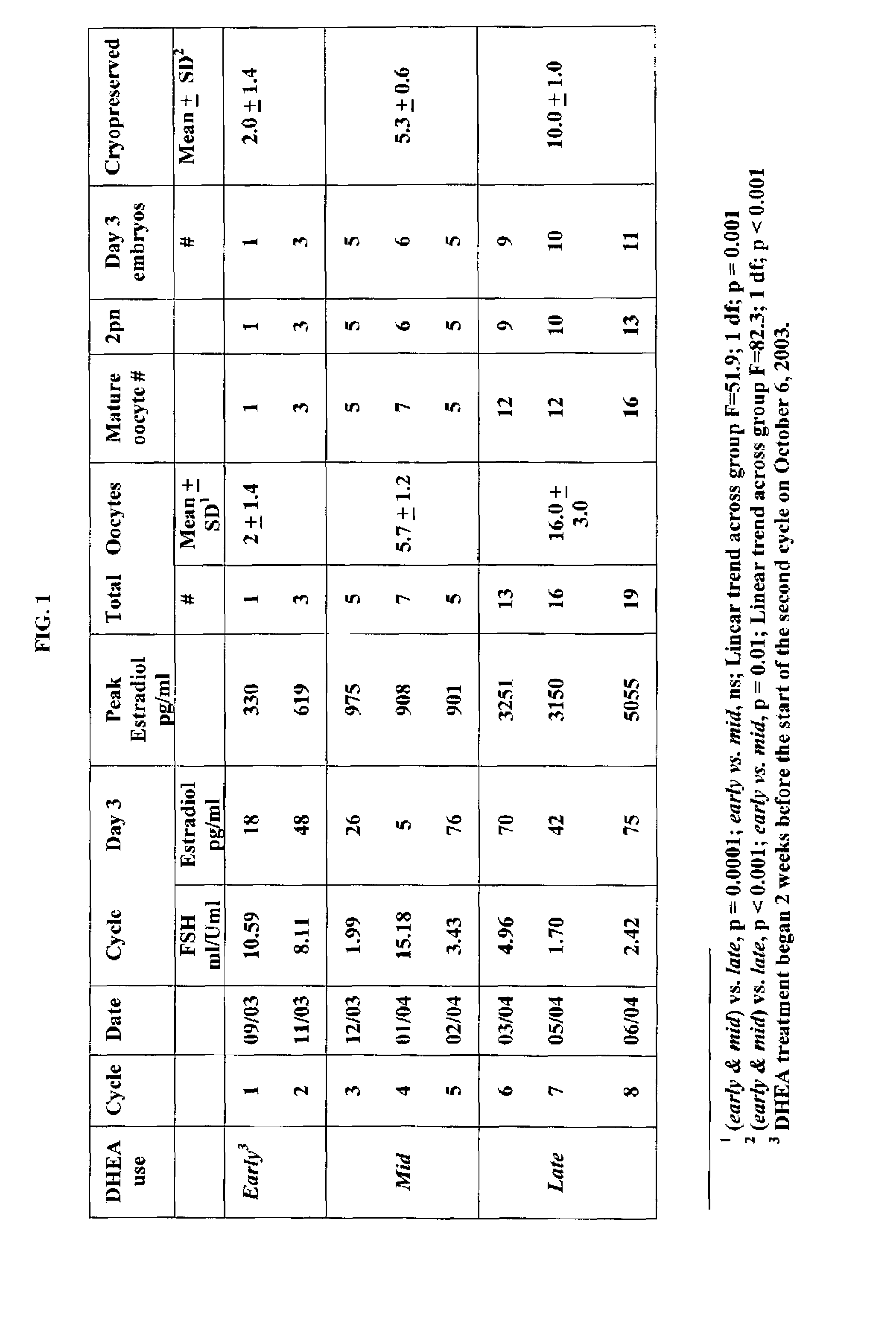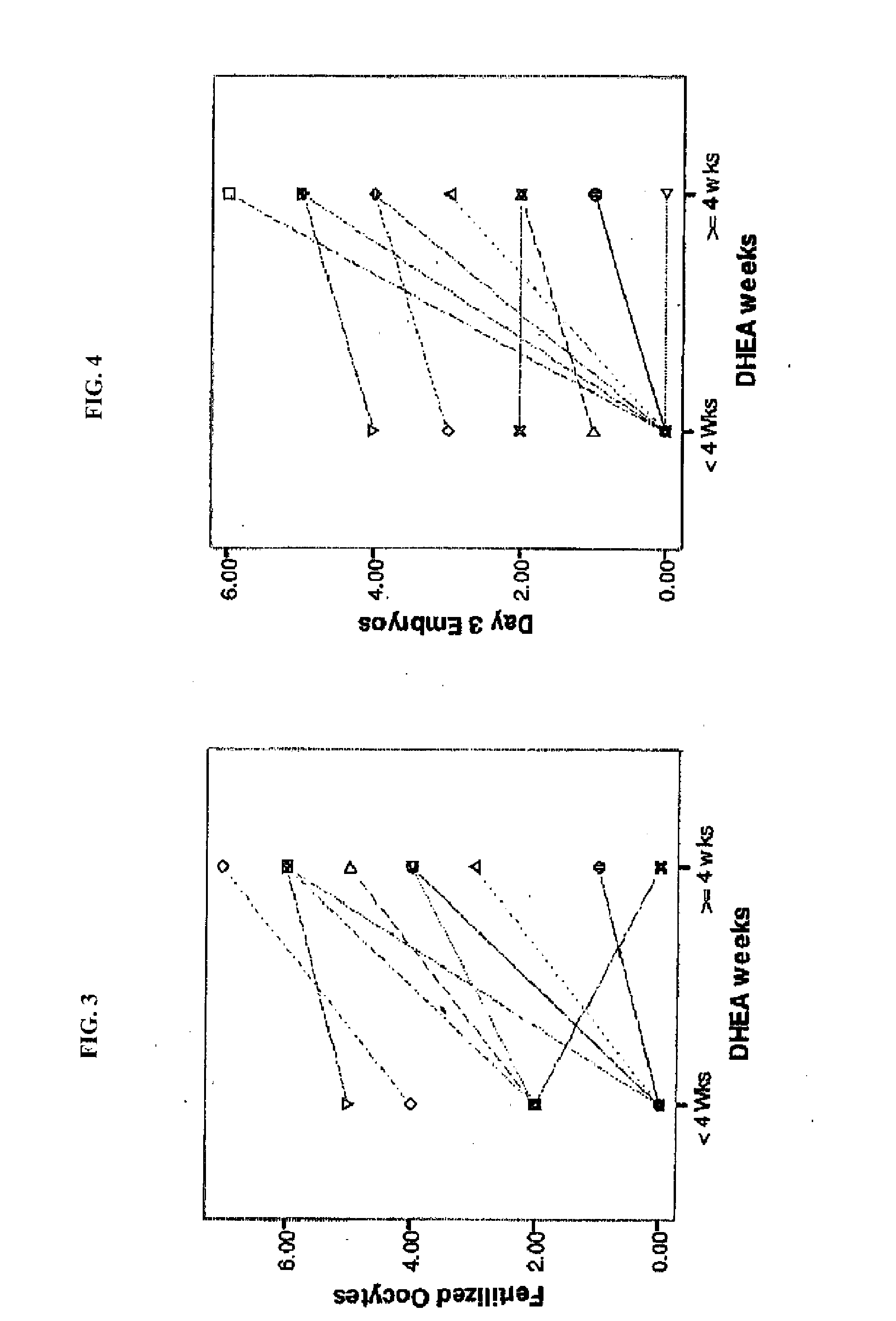Androgen treatment in females
a technology for androgen treatment and females, applied in the field of reproductive technology, can solve the problems of limited clinical utility of combined gh/ovarian stimulation, low ovarian function, and low response ra
- Summary
- Abstract
- Description
- Claims
- Application Information
AI Technical Summary
Benefits of technology
Problems solved by technology
Method used
Image
Examples
example 1
Results of Example 1
[0102]The results of ovulation induction are displayed in FIG. 1. After eight stimulation cycles and approximately eight months of DHEA treatment, Patient A produced 19 oocytes and 11 cryopreservable embryos. A total of 50 viable embryos have so far been cryopreserved. Significantly more oocytes (p=0.001) and cryopreserved embryos (p2, total oocyte, and embryos cryopreserved increase linearly from cycle to cycle, as shown in FIG. 1. Oocyte yield increase 2.5±0.34 oocytes per cycle (p2 increase 0.47±0.06 (p<0.001) across treatment cycles.
[0103]The linear increase in (log) peak E2 shown in FIG. 2 represents a cycle to cycle rate of increase from 123 pg / ml / cycle to 1491 pg / ml / cycle over the eight cycles of treatment. After adjusting for cycle day, the (harmonic) mean E2 is 267 pg / ml (95% confidence intervals (CI) 143 to 498 pg / ml) in the early phase, 941 pg / ml (95% CI 518 to 1712 pg / ml) in the mid phase, and 1780 pg / ml (95% CI 1121 to 2827 pg / ml) in the late phase o...
example 2
Improved Oocyte Fertilization and Cumulative Embryo Score
[0106]In another study, thirty (30) patients with evidence of decreased ovarian reserve were given supplemental DHEA 25 mg three times a day, for a total of 75 mg per day, for an average of about 4 months before beginning ovulation induction for IVF. Twelve patients contributed data from cycles both pre-DHEA and post-DHEA, eleven patients contributed data from cycles only pre-DHEA, and seven patients contributed data from cycles only post-DHEA. Patients' response to ovulation induction before DHEA treatment was compared to patients' response to ovulation induction after DHEA treatment with regard to peak estradiol, oocyte production, and embryos transferred and embryo quality.
[0107]The thirty patients contributed to data for 42 total cycles, 23 cycles prior to and 19 cycles after starting DHEA supplementation. In comparing the patients as a group pre- and post-DHEA treatment cycles, there were improvements in cancellation rate...
example 3
Increased Euploidy Rate
[0114]In another study (data not shown), patients were analyzed after four weeks of DHEA treatment. Seven patients had embryos tested by pre-implantation genetic diagnosis (PGD). In three women who had PGD after less than four weeks of DHEA usage and a mean age 41.5±5.1 at the time of starting IVF cycles, the euploidy, or normal chromosome number, rate was 2 / 30 embryos (6.6%). In six patients who had PGD after more than four weeks of DHEA usage, and a mean age of 43.7±1.3 years at the time of starting IVF cycles, the euploidy rate increased to (8 / 27; 29.6%), though this trend did not reach statistical significance. There is a mean age difference between patients who underwent IVF after less than four weeks of DHEA usage (mean age 41.5±5.1) and patients who underwent IVF after at least four weeks of DHEA usage (mean age 43.7±1.3).
[0115]As women age, there is a substantial decline in euploidy rates in embryos produced. Thus, the increase in euploidy results in o...
PUM
| Property | Measurement | Unit |
|---|---|---|
| Fraction | aaaaa | aaaaa |
| Time | aaaaa | aaaaa |
| Time | aaaaa | aaaaa |
Abstract
Description
Claims
Application Information
 Login to View More
Login to View More - R&D
- Intellectual Property
- Life Sciences
- Materials
- Tech Scout
- Unparalleled Data Quality
- Higher Quality Content
- 60% Fewer Hallucinations
Browse by: Latest US Patents, China's latest patents, Technical Efficacy Thesaurus, Application Domain, Technology Topic, Popular Technical Reports.
© 2025 PatSnap. All rights reserved.Legal|Privacy policy|Modern Slavery Act Transparency Statement|Sitemap|About US| Contact US: help@patsnap.com



